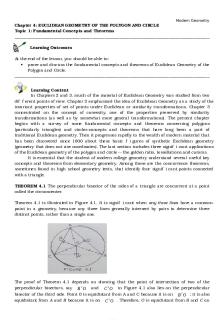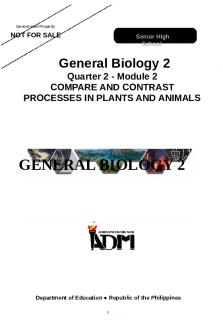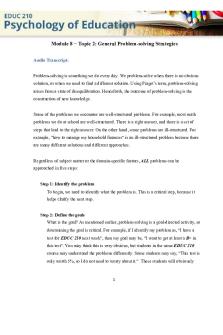Module 8 - Topic 2 -1. General Problem-Solving Strategies podcast PDF

| Title | Module 8 - Topic 2 -1. General Problem-Solving Strategies podcast |
|---|---|
| Author | je ge |
| Course | Psychology of Education |
| Institution | Concordia University |
| Pages | 3 |
| File Size | 167.3 KB |
| File Type | |
| Total Downloads | 99 |
| Total Views | 174 |
Summary
course website notes. course website notes....
Description
Module 8 − Topic 2: General Problem-solving Strategies Audio Transcript: Problem-solving is something we do every day. We problem-solve when there is no obvious solution, or when we need to find a different solution. Using Piaget’s term, problem-solving arises from a state of disequilibration. Henceforth, the outcome of problem-solving is the construction of new knowledge.
Some of the problems we encounter are well-structured problems. For example, most math problems we do at school are well-structured. There is a right answer, and there is a set of steps that lead to the right answer. On the other hand, some problems are ill-structured. For example, “how to manage my household finances” is an ill-structured problem because there are many different solutions and different approaches.
Regardless of subject matter or the domain-specific factors, ALL problems can be approached in five steps:
Step 1: Identify the problem To begin, we need to identify what the problem is. This is a critical step, because it helps clarify the next step.
Step 2: Define the goals What is the goal? As mentioned earlier, problem-solving is a goal-directed activity, so determining the goal is critical. For example, if I identify my problem as, “I have a test for EDUC 210 next week”, then my goal may be, “I want to get at least a B+ in this test”. You may think this is very obvious, but students in the same EDUC 210 course may understand the problems differently. Some students may say, “This test is only worth 5%, so I do not need to worry about it.” These students will obviously
1
have a very different goal, and very different approach to the problem. They may not study at all.
Step 3: Explore possible solution strategies Once we understand a problem and have a clear goal, we will need to figure out what are the most effective strategies to achieve the goal. If getting a B+ in the test is my goal, I will then proceed to find solutions, or strategies to help me achieve this goal. I may simply do what I have always done, because I figure that a test is a test — thus it comes down to the same thing! This would be an example of a schema-driven problem solving procedure.
In general, some problems can be solved by an algorithm, which is a step-by-step procedure that would surely lead you to the solution or right answer. In math computations, we often refer to algorithms for multiplication, division, solving an equation, etc.
However, many real life problems are not so straightforward, and we may have to use heuristics, which are more general strategies. You can probably think of many instances when you used heuristics to solve problems. For example, to determine when you need to leave your house in order to get to school on time, you might use a working-backwards strategy, starting at the time you need to arrive at school, and then calculating how much time you need to allot for the metro/bus ride, etc.
Step 4: Anticipate outcomes and acting After exploring and choosing a solution plan, the next step is to carry out the solution plan and to anticipate any problems that may interfere with your plan.
2
Step 5: Evaluate the outcome And finally, you must evaluate the outcome, making sure that you are meeting your goal(s). If your solution plan is ineffective, you may wish to re-start the problemsolving steps to find a new solution.
Summary:
Problem-solving o Problem-solving is a goal-directed activity that leads to learning and knowledge construction o Problems can be:
Well-structured
Ill-structured
General problem-solving strategies: 1. Identify the problem 2. Define the goals 3. Explore possible solution strategies 4. Anticipate outcomes and acting 5. Evaluate the outcome
3 ...
Similar Free PDFs

Module 2 Topic 1
- 1 Pages

Module 5 Topic 1
- 2 Pages

Module 3 Topic 1
- 1 Pages

Podcast - Nota: 8 DESCRI
- 1 Pages

RAE e-book Module 2 - Topic 1
- 13 Pages

Topic 8 DQ 1
- 2 Pages

General Chemistry 1 Q2 Module 2
- 35 Pages

Chapter 4 Topic 2 Module
- 6 Pages

Chapter 4 Topic 1 Module
- 6 Pages

General Biology 2 Quarter 2 Module 2
- 52 Pages

Options Trading Strategies Module
- 52 Pages
Popular Institutions
- Tinajero National High School - Annex
- Politeknik Caltex Riau
- Yokohama City University
- SGT University
- University of Al-Qadisiyah
- Divine Word College of Vigan
- Techniek College Rotterdam
- Universidade de Santiago
- Universiti Teknologi MARA Cawangan Johor Kampus Pasir Gudang
- Poltekkes Kemenkes Yogyakarta
- Baguio City National High School
- Colegio san marcos
- preparatoria uno
- Centro de Bachillerato Tecnológico Industrial y de Servicios No. 107
- Dalian Maritime University
- Quang Trung Secondary School
- Colegio Tecnológico en Informática
- Corporación Regional de Educación Superior
- Grupo CEDVA
- Dar Al Uloom University
- Centro de Estudios Preuniversitarios de la Universidad Nacional de Ingeniería
- 上智大学
- Aakash International School, Nuna Majara
- San Felipe Neri Catholic School
- Kang Chiao International School - New Taipei City
- Misamis Occidental National High School
- Institución Educativa Escuela Normal Juan Ladrilleros
- Kolehiyo ng Pantukan
- Batanes State College
- Instituto Continental
- Sekolah Menengah Kejuruan Kesehatan Kaltara (Tarakan)
- Colegio de La Inmaculada Concepcion - Cebu




